Projects require many resources. Everything from the people you’re working with and the equipment they’re using, to the materials and other supplies you need to even the site where you’re working falls under the umbrella of project resource allocation. Let’s explore what resource allocation is, why it’s so important for project management and what tools you can use to better allocate your project resources.
What Is Resource Allocation?
Resource allocation is the process of scheduling resources such as labor, materials or equipment to complete tasks. Organizations need resources to carry out the processes they operate normally and to execute operational and strategic projects to achieve specific goals.
This means the resource allocation process is integral in project management and strategic planning. Here’s a quick overview of the importance of resource allocation in these two areas.
Resource Allocation in Project Management
Resource allocation is a step in the larger project resource management process that involves estimating resources, procuring resources, allocating resources and tracking resources until the project is completed. The main objective of the project resource allocation stage is to ensure that resources are spent as efficiently as possible to minimize costs and avoid delays.
If a project team overspends resources on a task, the whole project schedule and budget might be affected as these resources need to be acquired again, generating additional costs and possibly extending the project timeline.
Once you’ve acquired your project resources, you should use project management software to plan how they’ll be allocated. That way you can coordinate them with your project schedule and distribute them across your team. In ProjectManager, for instance, you can manage your project schedule, team and non-human resources in one place. Build your schedule on a Gantt and track your resource distribution, progress and labor costs in one software. Try it free today!

Resource Allocation Example
To better understand resource allocation, let’s look at a real-life example. In this case, we’ll review the construction of a 10-story office building located in an urban business district. The timeline for the project is 12 months. As with most construction projects, the first stage of execution involves site preparation, foundation work and then structural construction.
This work will be done across multiple teams, including engineers, architects, construction workers, electricians and interior designers. These organizational resources must be effectively utilized to make sure that skilled personnel, materials and equipment are deployed at the right time to avoid delays and cost overruns. The project has been divided into phases, teams assigned to work from site preparation to final handover and contingency plans are drawn up to respond quickly to unexpected issues that could impact the project scope.
In terms of resource allocation, labor will be first listed and the roles and responsibilities of team members will be defined. The number of people required is then added, such as one project manager, 20 construction workers and so forth. The utilization timeline is determined and tasks are outlined.

The same is done for materials. They’re listed and the quantity needed is determined as well as the duration of their need in the project. The tasks in which these materials are used are also defined and any resource constraints affecting their allocation are identified.

The next organizational resource to be allocated is equipment. Again, the needed equipment is listed, the number of each noted and the timeframe in which the equipment will be used in the project as well as the tasks they’ll be used for.

Finance is also a resource and it requires the same breakdown. Financial resources are listed, the allocated budget calculated, the timeframe estimate and the purpose for the funds are defined.

Resource Allocation Template
While project management software is a better tool to use for resource allocation, those not ready to upgrade can use this free resource allocation template for Excel or any of our free resource management templates. It lists all the resources required to execute the project, their role, quantity, duration, tasks and more.
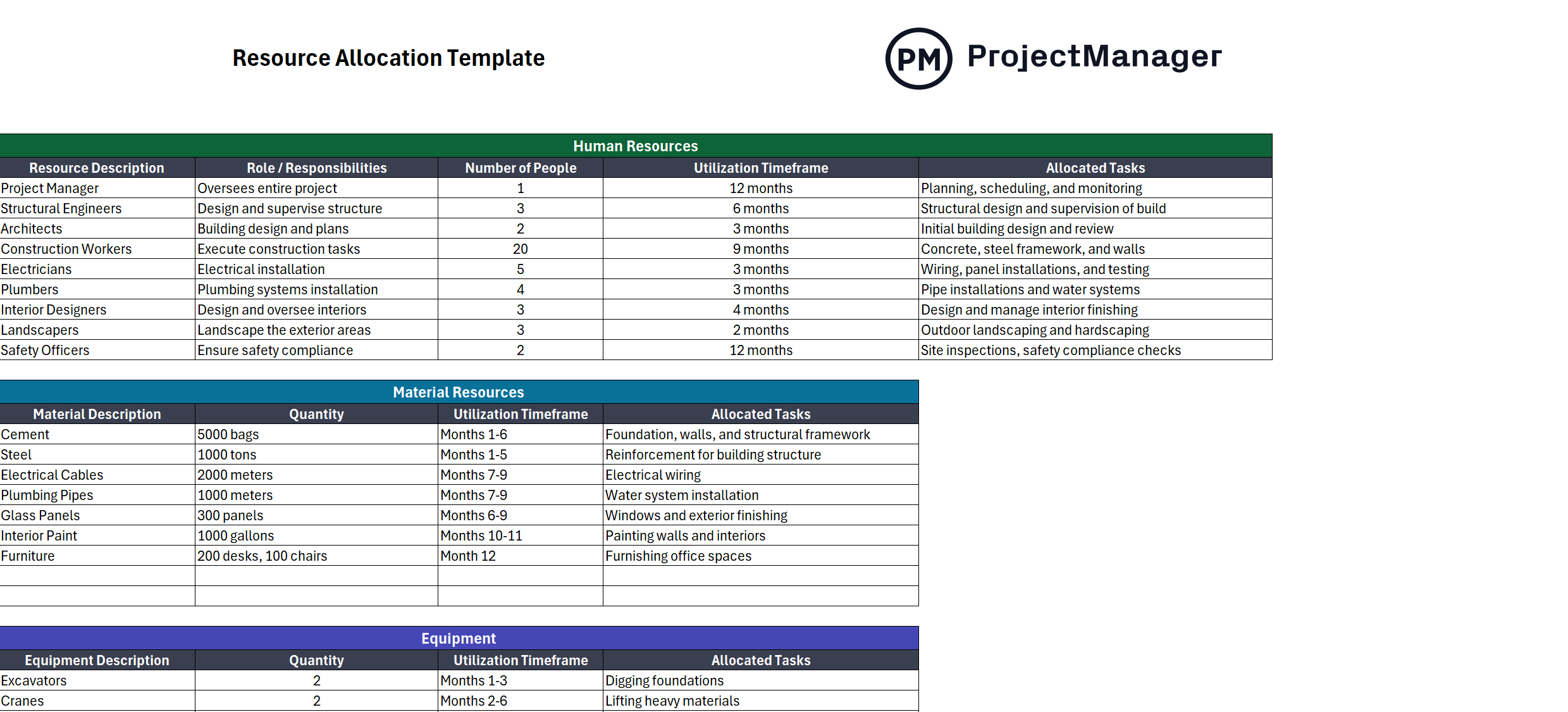
Resource Allocation in Strategic Management
Resource allocation plays an important role when an organization is planning its business strategy for the future. This is described in a document known as the strategic plan, which outlines the key goals and objectives of the organization for a period from three to five years.
These goals and objectives are accompanied by an action plan detailing the actions, projects and strategic initiatives the organization will take to achieve them. All of these require resources, which need to be acquired, allocated and monitored.
Why Is Resource Allocation Important?
As difficult as it might be to allocate resources correctly over the life cycle of a project, it’s an essential part of any thorough project management plan and should be done in the planning stage of a project. This keeps costs down, maximizes productivity and helps with team morale. It also facilitates client satisfaction by achieving the best outcome and successfully delivering the project.
What Is a Resource Allocation Plan?
A resource allocation plan describes in detail what resources will be utilized for each project task, noting quantities, specifications and due dates for their utilization. There’s no standard way of making a resource allocation plan, it might include a variety of resource management charts such as a resource allocation graph, project calendar, Gantt chart or any other diagram that can be used to visualize how resources are allocated over a project timeline or a project task list.
However, here are some basic elements that should be included in any resource allocation plan.
1. Identification of Resource Requirements
List all the resources by type, such as human, financial, physical and technology resources. This resource inventory is a critical first step in planning which resources are needed and when.
2. Overview of Current Resource Availability
To ensure that resources are delivered when they’re needed, they have to be available. Therefore, it’s important to understand the availability of resources. For example, human resources managers must know their working hours, when there are holidays, PTO and vacation time.
3. Resource Schedule
Create a timeline, which is a detailed schedule that outlines when each resource will be needed and for how long. Add milestones to indicate important dates, such as the end of one phase and the beginning of another. This will help track resource allocation and progress.
4. Cost of Resources
The next step is budgeting these resources, which requires estimating the financial funding for each resource, including salaries, materials, overhead, etc. Keep in mind that any budget limitations may affect resource allocation decisions.
5. Resource Tracking Tools and Techniques
Once the project is underway, resource tracking is essential to avoid delays and cost overruns. Methods for tracking resource usage and availability must be determined. Performance metrics should also be defined to assess the effectiveness of resource allocation.
In most cases, the resource allocation plan is part of the resource management plan, a document that guides all the project team’s resource management efforts.
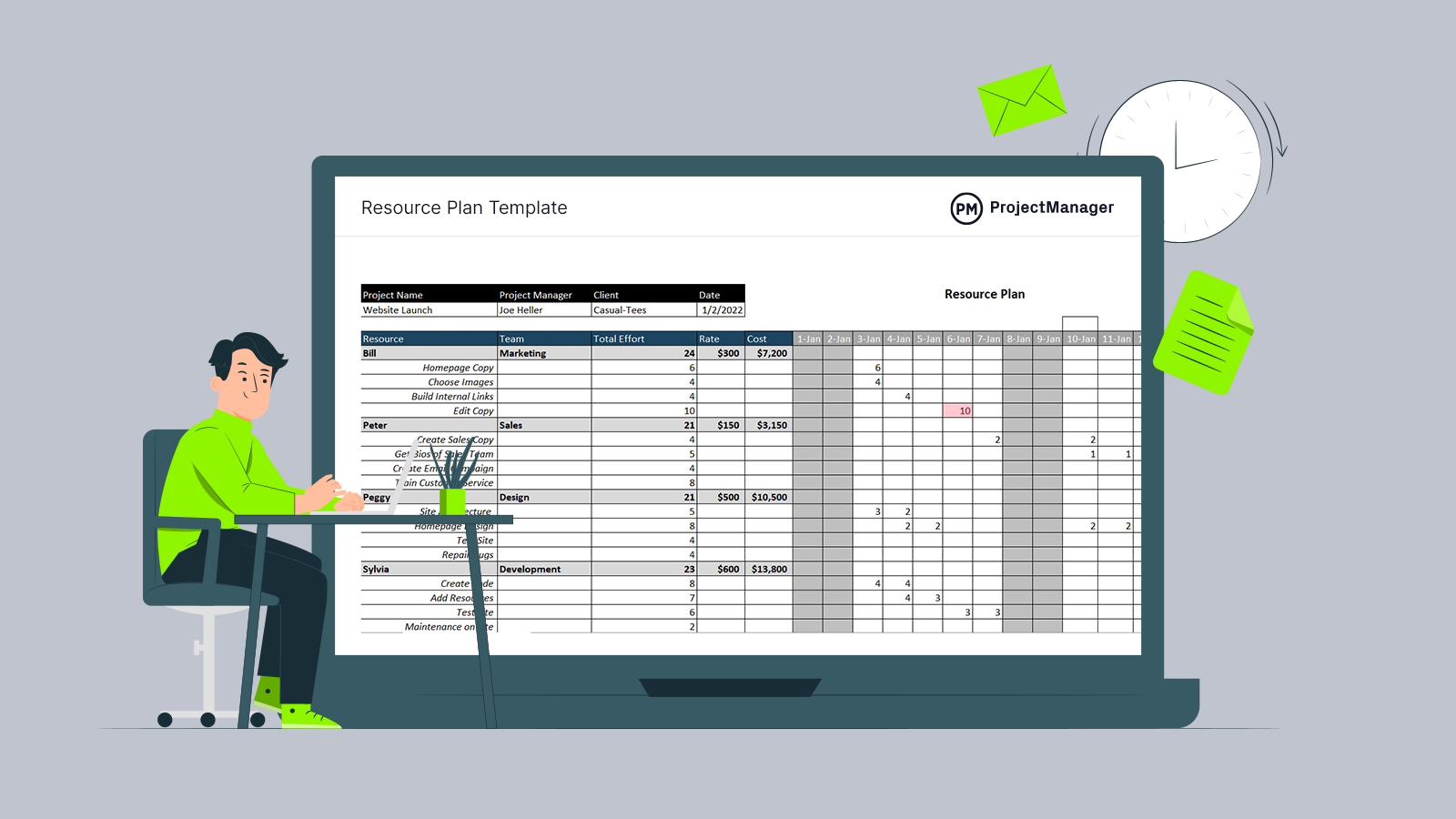
Get your free
Resource Allocation Template
Use this free Resource Allocation Template for Excel to manage your projects better.
What Does a Resource Allocator Do?
A resource allocator can take many different names, but essentially this is a role that acts as a liaison between the project management office and HR, finance, accounting or any other business departments throughout the organization to ensure that project resources are acquired and allocated effectively.
Resource Allocation Software
Resource allocation software is equipped with resource management tools that help organizations allocate resources for the completion of projects or operational activities and processes. For example, ProjectManager is a robust project management software with advanced resource allocation features such as Gantt charts, workload management charts, timesheets, real-time dashboards and much more. These tools will help make a resource schedule, reallocate resources, track resource availability and utilization rate and much more.
Resource Allocation Methods
The specific resource allocation method your organization implements depends on your industry and the nature of how resources are managed. For example, manufacturing companies might focus on raw materials and equipment while a professional services company might focus on team utilization and financial resources.
Regardless, it’s important to balance resource allocation with involved stakeholders. This could include teams, departments, customers, shareholders and other stakeholders. We’ve outlined some commonly utilized resource allocation methods for you to consider.
- Critical Path Method: In project management, the longest chain of dependent tasks is referred to as the critical path. By outlining a straightforward priority for task completion before the project starts, the CPM helps use resources as efficiently as possible. However, one criticism is that this method doesn’t allow for multitasking.
- Resource Leveling: To implement resource leveling, start by looking at the capacity of your team to determine how much work they can handle. Compare this with demand. If resources aren’t aligned with demand, reschedule tasks accordingly.
- Resource Smoothing: Resource smoothing aims to reduce demand while executing the project within the ideal timeframe. During this method, the project manager makes adjustments to resource scheduling and allocation. For example, if you’re under a time crunch, you might bring on a more seasoned person who can complete the work faster.
Resource Allocation Tools
Now that we’ve explained some popular resource allocation methods, let’s examine some of the tools project managers can use along the way.
Gantt Charts
Gantt charts provide an easy way to map the required project tasks and note dependencies. You’ll be able to see and allocate your resources across a project timeline, so you know exactly when you’ll need each resource. Once you’ve identified your tasks, you can assign them on the Gantt chart and see how long each team member has spent working on each task.
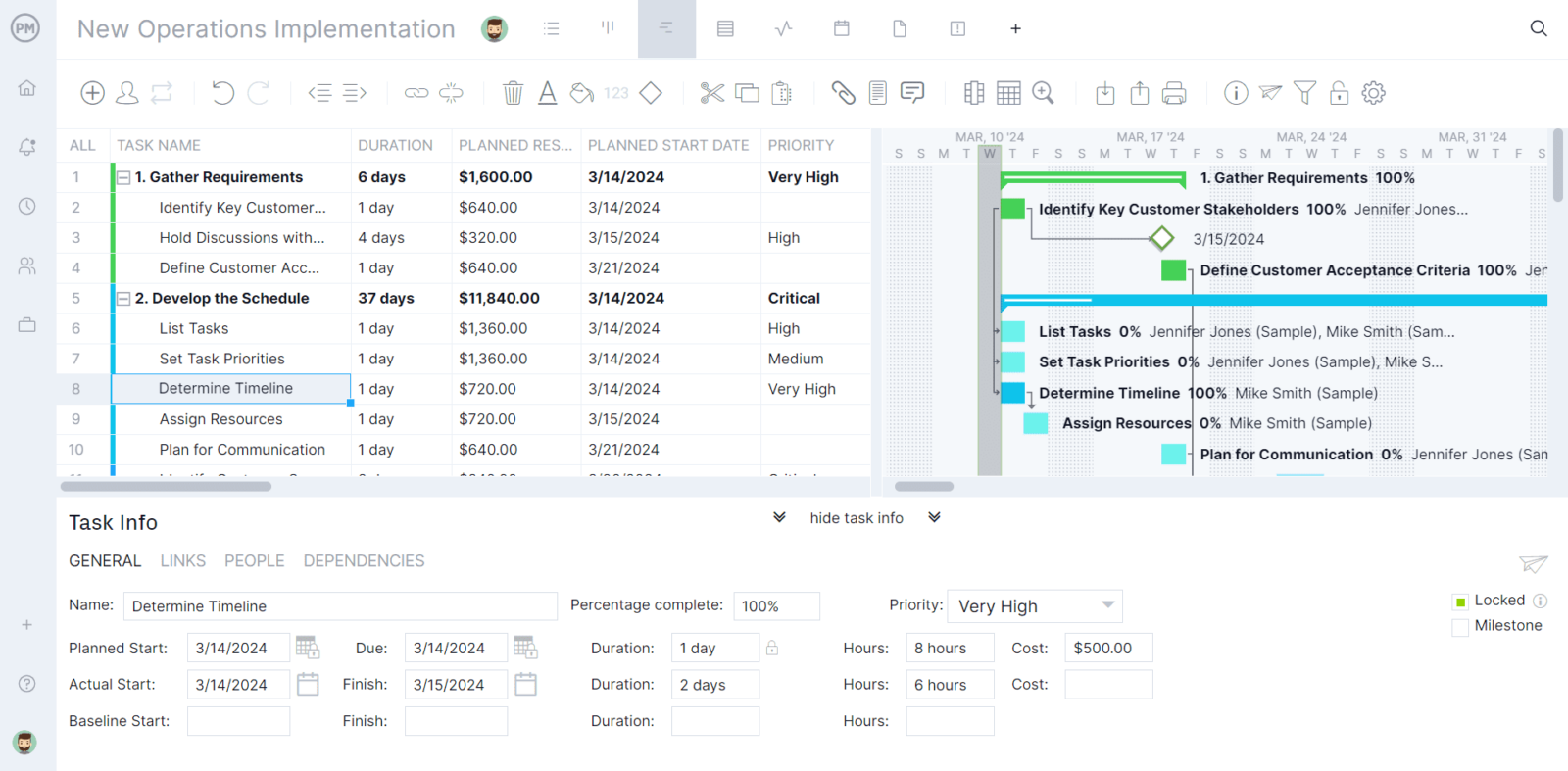
Workload Charts
These project management charts visually represent your resource allocation for your project team, department or entire company. You can see how many hours each person has been assigned and make adjustments to ensure your team is working at capacity. Use it to quickly determine how your human resource management aligns with your planned resource allocation.
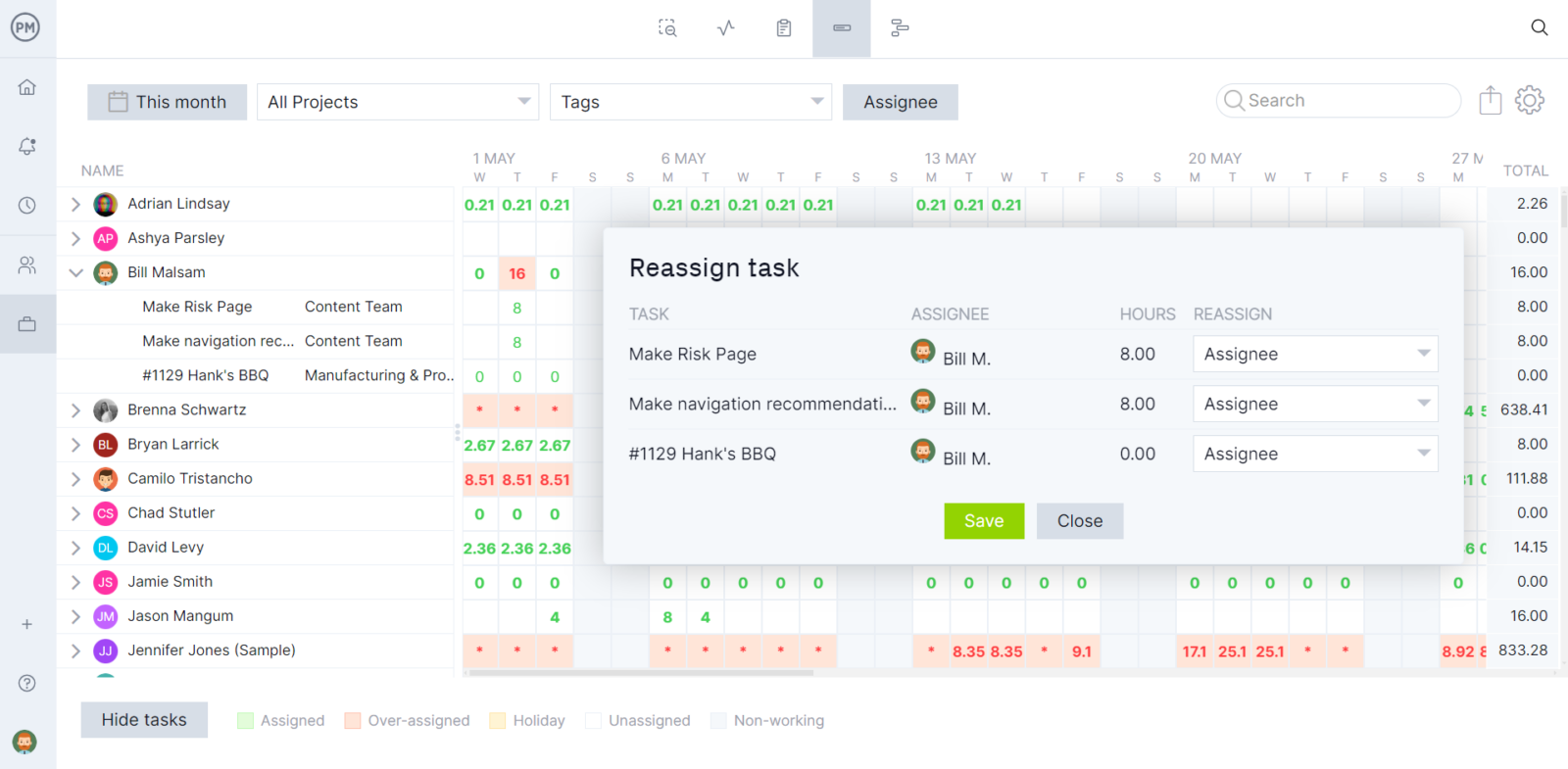
Resource Allocation Matrix
A resource allocation matrix is an overview of the needed project resources. It helps identify any potential bottlenecks or imbalances ahead of time. Typically, the matrix includes the names and roles of each team member, their availability and their skills and tasks on the project. It acts as a visual representation of your resources mapped against project tasks and activities.
Resource Breakdown Structure
This resource allocation tool is a hierarchical chart of the resources needed to execute your project and it includes everything from the people needed for the project to what you’ll be spending your money on. An RBS can include materials, equipment, people, project management tools and more.
Resource Histogram
A resource histogram is a bar chart that allows project managers to monitor the utilization of resources over the course of a project. It usually shows the percentage of human or non-human resources that has been allocated across time periods to help identify over or underallocation.
Resource Allocation Templates
Resources allocation requires accurate and timely data to avoid bottlenecks that can slow down your project. Project management software is the most efficient way to manage your resources, but if you don’t have an online resource management tool some templates can help. ProjectManager has free project management templates for every phase of your project, including ones to help with resource allocation. Here are a few.
Requirement Gathering Template
Before you can allocate resources, you need to understand what’s required. The free requirement gathering template for Word acts as a means of communication between the stakeholders and the project team. This ensures quality deliverables that meet specifications.
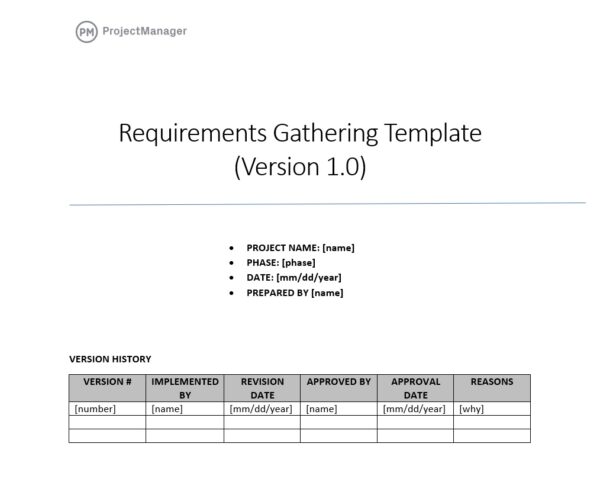
RACI Matrix Template
You’ll also need to organize your resources before you can properly allocate them. Our free RACI matrix template for Excel is a place where you can define the roles and responsibilities of the team members. RACI stands for responsible, accountable, consulted and informed, and the free template helps you place everyone involved in the project within one of those quadrants.

Resource Planning Template
Our free resource planning template for Excel lists all the resources you’ll need for the project, how much each will cost and a monthly, weekly or daily chart of when you’ll need them.
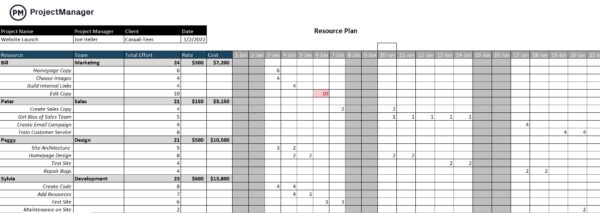
Capacity Planning Template
Leverage this free capacity planning template for Excel to ensure you’re able to meet customer demand. It helps you understand your organization’s resource capacity by outlining the utilization, time and effort for each team member to complete tasks.
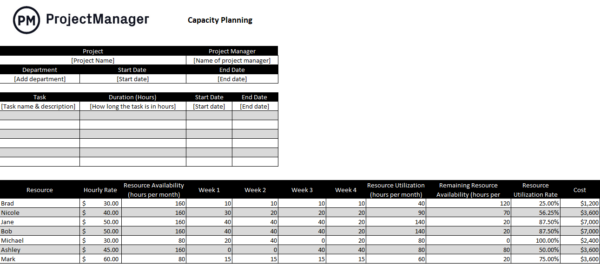
Workload Analysis Template
Use this workload analysis template to allocate work hours to employees and calculate their utilization rate and labor costs.
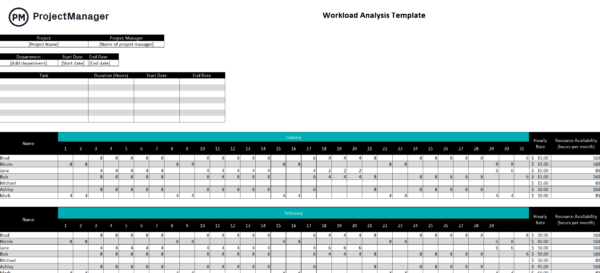
Project Dashboard Template
This free project dashboard template for Excel shows the project progress, costs and workload distribution in various charts and tables.
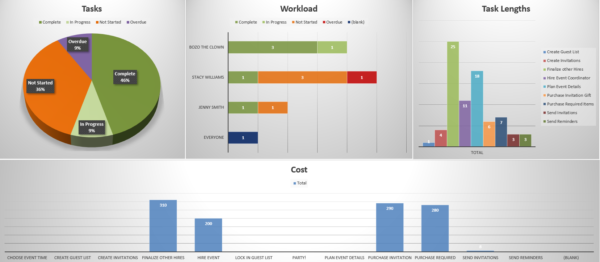
Resource Allocation Process: How to Allocate Project Resources
Resource allocation is a plan that you develop to make the most of the available resources at your disposal in a project, which makes it a critical resource planning activity. This is mostly a short-term plan set in place to achieve goals in the future.
This sounds challenging, but don’t worry, we’re here to help. The following are some general tips to help you with your resource allocation when managing a project.
1. Define Your Project Scope
Before you can allocate your resources or manage them, you have to determine the scope of the project you’re working on. To do so, you need to break down the project into every individual task and deliverable that will be completed. Once you’ve done so, you can make the right decision on what resources you’ll need and how many of them are necessary to complete the project.
The clearer the project scope is, the better you’ll be able to figure out how to allocate your resources. Take the time to get the full picture of the project using a work breakdown structure or other project planning tools to visualize all your project tasks before estimating your resources.

2. Estimate What Project Resources Will Be Needed
Once you’ve defined your project scope, you can move to the resource planning phase which is when you’ll have to estimate what resources will be needed including people, equipment, materials and anything else you’re going to need to complete your project tasks. Your organization will have some of these resources already, while others will need to be purchased or rented.
Before you can allocate resources, you have to have them. So, make a list using the criteria above and make sure it fits within the project budget.

3. Assess Your Current Resource Utilization & Resource Availability
Now that you’ve determined what resources are required for your project, you should also identify which of those resources are available within your organization. However, some existing resources might be being used for other projects, so it’s important that you not only identify which resources your organization has but also which of those are being utilized.
4. Create a Resource Allocation Plan
Take the information that you’ve gained from the above steps to put together a resource allocation plan. Outline the list of resources you’ll need for your project as well as the cost and quantity of each. When you’re finished, circle back to your project scope to make sure your plan aligns with it.
5. Keep Track of Your Project Resources
It’s a problem when you’re so focused on the process that you neglect to lift your head from the resource allocation plan to note what’s happening. This isn’t merely tracking your estimates against actual progress in the project, though that’s important, too.
You should always be aware of the state of your resources. For example, what’s the schedule for your team, are any taking vacation time, are they sick, etc.? Also, what’s the duration of the lease for the site or equipment? These are important questions to ask when scheduling resources.
Don’t let these details get past you because of tunnel vision. Look at the whole project, not just the various pieces.
6. Use Resource Allocation Reports
You can reallocate if you don’t know where your resources are allocated. You might have planned them out well, but change happens in projects. How can you tell what’s happening on the ground compared to your plans? Project reports.
You can generate all sorts of reports to give you a full picture of the project and how it’s progressing, which helps you balance your resources. For example, resource reports give you an overview of your team’s workload and whether they’re over-tasked or idle.
Task reports keep you updated and variance reports help you determine whether the project is proceeding as planned. The latter gives you vital information, such as if you’re behind schedule and need to redistribute the work to get back on track.
Resource Allocation Example
Let’s say you’re a manager for an IT organization and you’re tasked with hiring an architect for an upcoming project. You know the importance of an architect position to the overall success of the project but you know that they’re usually an expensive hire.
You’ll need to consider if it makes more sense to hire an architect for a specific project or if you want to assign him or her to multiple projects. You can utilize resource allocation tools to determine what makes the most financial sense for your organization.

Resource Allocation Tips
Even though there may be blind spots when managing resources, there are some tips to keep in mind to help you allocate resources as effectively as possible.
Know Your Resource Dependencies
By planning beforehand, you can avoid bottlenecks that trap your resources when you need them most in the course of the project execution. Planning also helps you keep your resources from falling short. This doesn’t mean you won’t have a bottleneck or resource shortage, but it’s less likely if you know your resource dependencies.
Part of planning for dependencies is having a contingency plan in place in case team members are blocked or you run low on needed resources. Keep your plans from being over-dependent on one resource to avoid trouble down the line.
Track Time
You always want to keep a close eye on the time, how your team is working and if they’re being efficient. It’s your job to make sure that a task that can be completed in a day doesn’t take a week. There are ways to improve time tracking.
To do this, you must keep track of your team’s workload. That requires the right tools to give you real-time data collected on one page where you can see and schedule ahead when needed.
Use Resource Allocation Tools
Project management software like ProjectManager is a great asset for managing your resources more productively. With an online tool, you get project data instantly updated.
You can see where your resources are allocated across a calendar that’s color-coded to note whether they’re on- or off-task, on vacation or sick. Rescheduling to help a team member who is overtasked is a simple click of the keyboard.
How to Allocate Resources With ProjectManager
ProjectManager is robust project management software with multiple tools that allow project managers to allocate project resources, track utilization and availability, control costs and deliver project success. Regardless of how you prefer to manage and schedule your resources, ProjectManager has the tools to help you every step of the way. Here are some of our most popular resource management features.
Schedule Resources With Multiple Planning Tools
Tools such as Gantt charts, kanban boards, task lists and project calendars allow you to allocate resources in multiple ways. Use online Gantt charts to create interactive project timelines that let you easily assign the needed resources for each project task or create task lists that make it easy to stay on track. In addition, ProjectManager’s workload charts help you plan and oversee each team member’s workload at a glance so you can keep your team working at capacity.
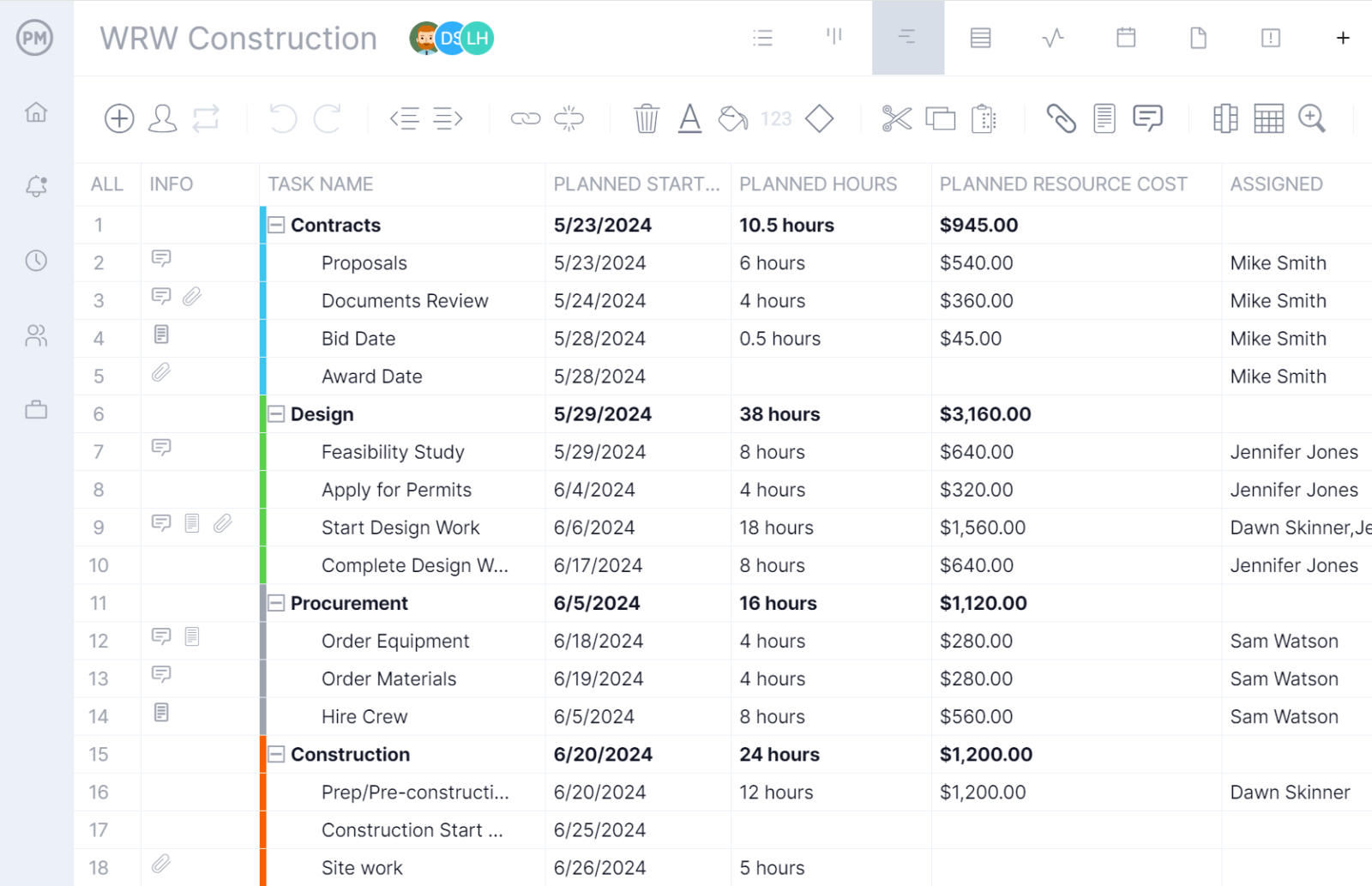
Track Costs With Project Dashboards & Timesheets
Once you’ve allocated your project resources, you’ll need to track their costs to ensure that you’re sticking to your budget. ProjectManager’s real-time dashboards make it easy to monitor costs, timelines and progress so nothing is overlooked. Use the dashboard to make timely updates and catch problems before they snowball. In addition, you can use our project timesheets to help you keep track of labor costs.
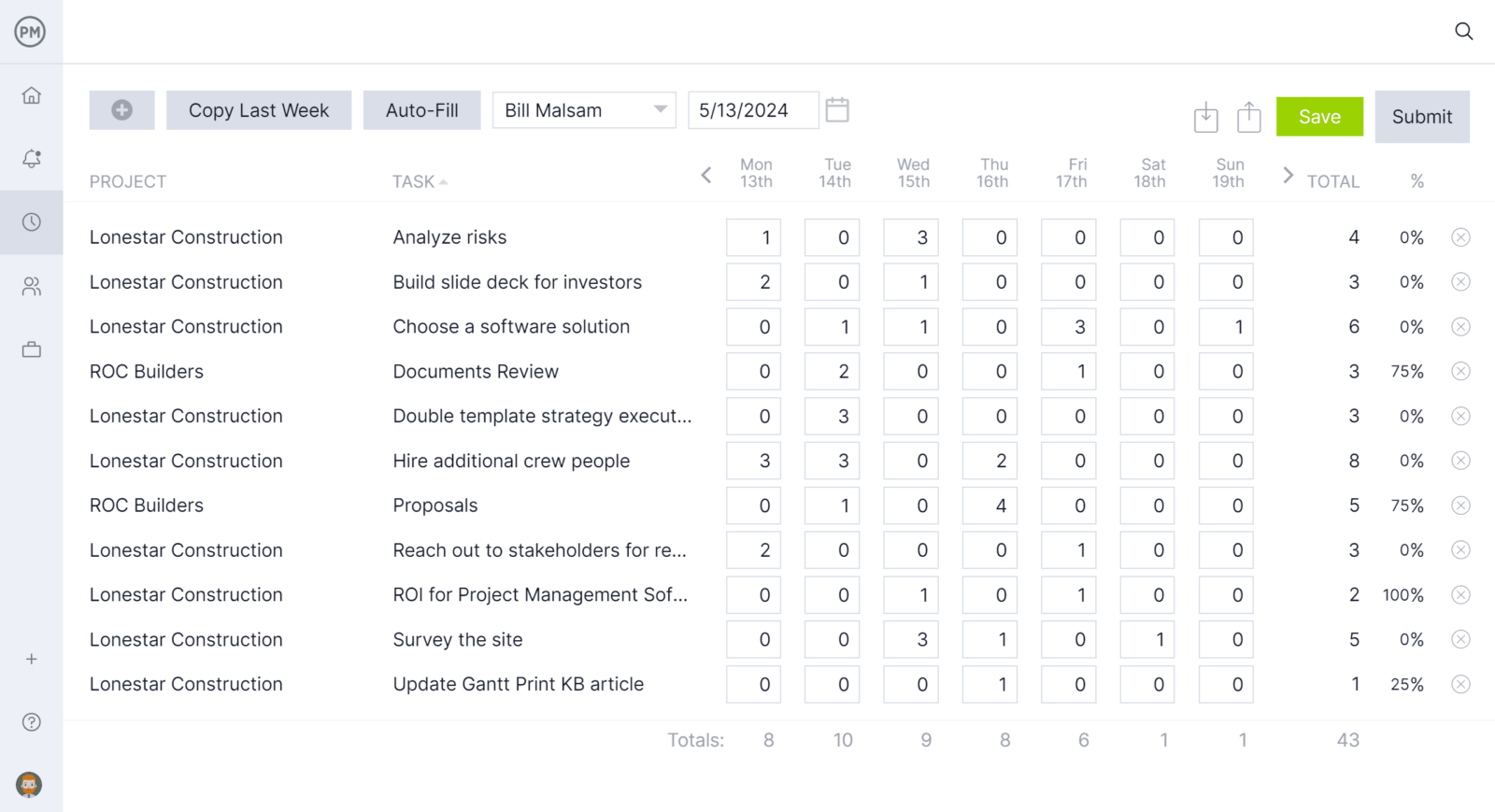
Related Content
If you’re still interested in resource management, you’ve come to the right place. ProjectManager isn’t just superior software, it’s the online hub for all things project management. You not only get free templates but regular blog posts, thorough eBooks, whitepapers and more. Here’s a sample of that content as related to our topic.
- ¿Qué es la asignación de recursos en la gestión de proyectos?
- Best Resource Management Software Rankings
- Resource Analysis in Project Management: Steps & Free Templates
- 5 Must-Have Resource Management Tools
- Resource Smoothing Steps, Templates and Tools
- Resource Forecasting in Project Management
- What Is Resource Optimization? Techniques & Best Practices
- What Is Resource Loading and Why Does It Matter in Project Management?
If you’re looking for a project management tool that can help you implement those tips and manage your resources properly, then look no further. ProjectManager has all the features mentioned above to help you manage your resources, and it’s online software, which means the information you’re working with is in real time. See how it can help you by taking this free 30-day trial today!

